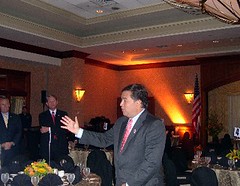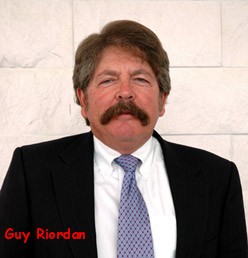January 8, 2009
 |
| Richardson in Boston, 2004 |
In case you’ve been on another planet for the past few days, a grand jury in Albuquerque has been looking at a California firm called CDR Financial Products, which did work on the funding of Richardson’s transportation construction program.
Shortly before and shortly after the New Mexico Finance Authority chose CDR for the work, the company and its chief executive contributed a total of $110,000 to Richardson PACs.
The biggest chunk of that was a $75,000 check from CDR on June 18, 2004, to a PAC called ¡Sí, Se Puede! Boston 2004 Inc. Richardson served as chairman of the Democratic Convention that year.
According to reports filed with the Internal Revenue Service, ¡Sí, Se Puede! raised $336,000 from the time it was formed in February 2004 until Nov. 19, 2004 — about four months after the convention — when Novartis Pharmaceuticals Corp. of New Jersey contributed $10,000 to the cause.
Richardson’s then-political director Amanda Cooper was listed as executor director of the PAC. Other directors included David Smoak, a state Judicial Standards commissioner; Fred Duval, a Phoenix consultant; Denver lawyer Ted Trimpa; Washington, D.C., businessman Miguel Lausell; and banker and Richardson crony Guy Riordan.

Yes, that Guy Riordan. In July, a Securities and Exchange Commission administrative law judge recommended Riordan be banned from the securities industry for life for paying bribes to former state Treasurer Michael Montoya. The SEC has not made a final decision in the case, and Riordan has not been charged with any crime. But after Montoya, who has pleaded guilty in a federal kickback case, testified about accepting bribes from Riordan, Richardson donated $44,000 in contributions from Riordan to charity.
CDR was the biggest donor to ¡Sí, Se Puede! Other companies that were part of the team responsible for the state’s transportation bonds — UBS Financial Services, RBC Dain Rauscher and George K. Baum and Company — gave Richardson’s PAC a total of $55,000.
Other large contributions to ¡Sí, Se Puede! include Amgen, a California-based biotechnology company, $25,000; Rancho Viejo, $25,000; Las Campanas, $20,000; AKAL Security, $20,000; Northern Trust Co., Chicago, $10,000; and the G-Tech Corp. of Rhode Island, $10,000.
G-Tech, a company called “baldly sleazy” by Fortune magazine in 1996, ran New Mexico’s lottery from 1996 until November. G-Tech, according to a 2006 study by Santa Fe think tank Think New Mexico, charged this state drastically higher fees than those paid by other states with similarly sized lotteries.
So how did ¡Sí, Se Puede! spend its money?
As makes sense, a large portion of the expenditures was for hotels and airfare. More than 10 members of Richardson’s staff — including his political staff, three press spokesmen and state police officers on his security detail — went. (The state, not the PAC, paid for the police expenses.)
It’s difficult to determine just how much was spent on hotels. Several hotels are listed — Doubletree, Hilton, Hotel Marlowe, Hotel MIT, Hyatt, Ritz Carlton, Sheraton, Wyndham and the “Northeastern dorms.” However in later reports, several of these refunded money to the PAC.
The PAC also paid a limousine company called Lifestyle Transportation International more than $13,000 for convention transportation.
One of the biggest single expenses was $23,000 to Grand Canel, an Irish pub, for a “special event” during the convention.
Mike Contarino — a political science professor at the University of New Hampshire and brother of Richardson’s then Chief of Staff Dave Contarino, was paid a $500 consultant fee. (Mike Contarino later would become a foreign policy adviser for the 2008 Richardson presidential campaign.)
Michael Jacobs, an Albuquerque photographer, was paid $2,419.
State Public Education Secretary Veronica Garcia was paid $985 for “convention related travel and per diem spending.” Garcia on Wednesday explained she had been asked by the John Kerry campaign to speak about education at the convention. Her ticket was expensive, she said, because she’d booked a flight for later in the week but was told by the campaign they’d rescheduled her speech for the next day. “I flew in, gave my speech and flew back the next day,” Garcia said.
In late 2004 and even into 2005, the PAC still was paying bills. But there was plenty of money left over. ¡Sí, Se Puede! ended up donating $87,827 to the Democratic Governor’s Association, of which Richardson was elected chairman in December 2004 and which would be the conduit for much of Richardson’s travel expenses for the next two years.




